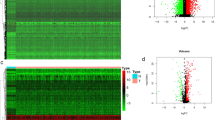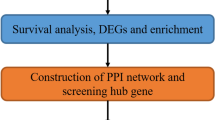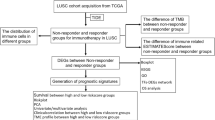Abstract
The genes that control drug absorption, distribution, metabolism, and excretion (ADME) are also involved in carcinogenesis, cancer progression, and chemoresistance. However, no studies have systematically investigated the clinical significance and underlying functions of ADME genes in head and neck squamous cell carcinoma. Herein, we comprehensively explored the ADME genes in this disease, constructed and validated as a prognostic ADME gene signature (ADMEGS), using three ADME genes (ABCB1, ALDH1B1, and PON2) utilizing multiple datasets, including the training and test sets of The Cancer Genome Atlas and the Gene Expression Omnibus validation set. Moreover, we analyzed the relationship between the ADMEGS and clinical parameters, tumor immunity, and therapeutic response. We found that the ADMEGS was significantly correlated with the clinical, T, and N stages. Additionally, we were able to effectively differentiate tumor immune scores, immune cell infiltration statuses, and treatment responses based on the ADMEGS. As such, ADMEGS may be promising predictors for clinical outcome, tumor immunity, and treatment response.
This is a preview of subscription content, access via your institution
Access options
Subscribe to this journal
Receive 12 print issues and online access
$259.00 per year
only $21.58 per issue
Buy this article
- Purchase on Springer Link
- Instant access to full article PDF
Prices may be subject to local taxes which are calculated during checkout







Similar content being viewed by others
Data availability
The HTSeq-FPKM and clinical data of HNSCC datasets can be obtained from The Cancer Genome Atlas (TCGA) (https://portal.gdc.cancer.gov/) and Gene Expression Omnibus (GEO) database (https://www.ncbi.nlm.nih.gov/geo/).
References
Siegel RL, Miller KD, Jemal A. Cancer statistics, 2020. CA Cancer J Clin. 2020;70:7–30.
Argiris A, Karamouzis MV, Raben D, Ferris RL. Head and neck cancer. Lancet (Lond, Engl). 2008;371:1695–709.
Cramer JD, Burtness B, Le QT, Ferris RL. The changing therapeutic landscape of head and neck cancer. Nat Rev Clin Oncol. 2019;16:669–83.
Leemans CR, Snijders PJF, Brakenhoff RH. The molecular landscape of head and neck cancer. Nat Rev Cancer. 2018;18:269–82.
Ferris RL, Blumenschein G Jr, Fayette J, Guigay J, Colevas AD, Licitra L, et al. Nivolumab for recurrent squamous-cell carcinoma of the head and neck. N Engl J Med. 2016;375:1856–67.
Ferris RL, Blumenschein G Jr, Fayette J, Guigay J, Colevas AD, Licitra L, et al. Nivolumab vs investigator’s choice in recurrent or metastatic squamous cell carcinoma of the head and neck: 2-year long-term survival update of CheckMate 141 with analyses by tumor PD-L1 expression. Oral Oncol. 2018;81:45–51.
Cohen EEW, Soulieres D, Le Tourneau C, Dinis J, Licitra L, Ahn MJ, et al. Pembrolizumab versus methotrexate, docetaxel, or cetuximab for recurrent or metastatic head-and-neck squamous cell carcinoma (KEYNOTE-040): a randomised, open-label, phase 3 study. Lancet. 2019;393:156–67.
Hovelson DH, Xue Z, Zawistowski M, Ehm MG, Harris EC, Stocker SL, et al. Characterization of ADME gene variation in 21 populations by exome sequencing. Pharmacogenet Genomics. 2017;27:89–100.
Klein K, Tremmel R, Winter S, Fehr S, Battke F, Scheurenbrand T, et al. A new panel-based next-generation sequencing method for ADME genes reveals novel associations of common and rare variants with expression in a human liver cohort. Front Genet. 2019;10:7.
Hu DG, Marri S, McKinnon RA, Mackenzie PI, Meech R. Deregulation of the genes that are involved in drug absorption, distribution, metabolism, and excretion in hepatocellular carcinoma. J Pharm Exp Ther. 2019;368:363–81.
Ziniel PD, Karumudi B, Barnard AH, Fisher EM, Thatcher GR, Podust LM, et al. The Schistosoma mansoni cytochrome P450 (CYP3050A1) IS Essential for Worm Survival and Egg Development. PLoS Negl Trop Dis. 2015;9:e0004279.
Alzahrani AM, Rajendran P. The multifarious link between cytochrome P450s and cancer. Oxid Med Cell Longev. 2020;2020:3028387.
Jancova P, Anzenbacher P, Anzenbacherova E. Phase II drug metabolizing enzymes. Biomed Pap Med Fac Univ Palacky Olomouc Czech Repub. 2010;154:103–16.
Nigam SK. What do drug transporters really do? Nat Rev Drug Disco. 2015;14:29–44.
Rees DC, Johnson E, Lewinson O. ABC transporters: the power to change. Nat Rev Mol Cell Biol. 2009;10:218–27.
Liu X. ABC family transporters. Adv Exp Med Biol. 2019;1141:13–100.
Gamage N, Barnett A, Hempel N, Duggleby RG, Windmill KF, Martin JL, et al. Human sulfotransferases and their role in chemical metabolism. Toxicol Sci. 2006;90:5–22.
Hu DG, Mackenzie PI, McKinnon RA, Meech R. Genetic polymorphisms of human UDP-glucuronosyltransferase (UGT) genes and cancer risk. Drug Metab Rev. 2016;48:47–69.
Aka I, Bernal CJ, Carroll R, Maxwell-Horn A, Oshikoya KA, Van Driest SL. Clinical pharmacogenetics of Cytochrome P450-associated drugs in children. J Pers Med. 2017;7:14.
Kaur G, Gupta SK, Singh P, Ali V, Kumar V, Verma M. Drug-metabolizing enzymes: role in drug resistance in cancer. Clin Transl Oncol. 2020;22:1667–80.
Pathania S, Bhatia R, Baldi A, Singh R, Rawal RK. Drug metabolizing enzymes and their inhibitors’ role in cancer resistance. Biomed Pharmacother. 2018;105:53–65.
Johnson WE, Li C, Rabinovic A. Adjusting batch effects in microarray expression data using empirical Bayes methods. Biostatistics. 2007;8:118–27.
Newman AM, Liu CL, Green MR, Gentles AJ, Feng W, Xu Y, et al. Robust enumeration of cell subsets from tissue expression profiles. Nat Methods. 2015;12:453–7.
Yoshihara K, Shahmoradgoli M, Martinez E, Vegesna R, Kim H, Torres-Garcia W, et al. Inferring tumour purity and stromal and immune cell admixture from expression data. Nat Commun. 2013;4:2612.
Gong Y, Luo X, Yang J, Jiang Q, Liu Z. RIPK4 promoted the tumorigenicity of nasopharyngeal carcinoma cells. Biomed Pharmacother. 2018;108:1–6.
Liu ZF, Yang J, Wei SP, Luo XG, Jiang QS, Chen T, et al. Upregulated METTL3 in nasopharyngeal carcinoma enhances the motility of cancer cells. Kaohsiung J Med Sci. 2020;36:895–903.
Yang J, Gong Y, Jiang Q, Liu L, Li S, Zhou Q, et al. Circular RNA expression profiles in nasopharyngeal carcinoma by sequence analysis. Front Oncol. 2020;10:601.
Shrotriya S, Agarwal R, Sclafani RA. A perspective on chemoprevention by resveratrol in head and neck squamous cell carcinoma. Adv Exp Med Biol. 2015;815:333–48.
López-Verdín S, Lavalle-Carrasco J, Carreón-Burciaga RG, Serafín-Higuera N, Molina-Frechero N, González-González R. et al. Molecular markers of anticancer drug resistance in head and neck squamous cell carcinoma: a literature review. Cancers (Basel). 2018;10:376.
Shen B, Dong P, Li D, Gao S. Expression and function of ABCG2 in head and neck squamous cell carcinoma and cell lines. Exp Ther Med. 2011;2:1151–7.
Masood N, Kayani MA. Mutational analysis of xenobiotic metabolizing genes (CYP1A1 and GSTP1) in sporadic head and neck cancer patients. Genet Mol Biol. 2011;34:533–8.
Lacko M, Voogd AC, Roelofs HMJ, te Morsche RHM, Oude Ophuis MB, Peters WHM, et al. Combined effect of genetic polymorphisms in phase I and II biotransformation enzymes on head and neck cancer risk. Head Neck. 2013;35:858–67.
Roh J-L, Kim EH, Park JY, Kim JW. Inhibition of glucosylceramide synthase sensitizes head and neck cancer to cisplatin. Mol Cancer Ther. 2015;14:1907–15.
Guan G-F, Zhang DEJ, Zheng Y, Wen L-J, Yu D-J, Lu Y-Q, et al. Significance of ATP-binding cassette transporter proteins in multidrug resistance of head and neck squamous cell carcinoma. Oncol Lett. 2015;10:631–6.
Rooseboom M, Commandeur JNM, Vermeulen NPE. Enzyme-catalyzed activation of anticancer prodrugs. Pharmacol Rev. 2004;56:53–102.
Schroth W, Goetz MP, Hamann U, Fasching PA, Schmidt M, Winter S, et al. Association between CYP2D6 polymorphisms and outcomes among women with early stage breast cancer treated with tamoxifen. JAMA. 2009;302:1429–36.
Mizushima T, Tirador KA, Miyamoto H. Androgen receptor activation: a prospective therapeutic target for bladder cancer? Expert Opin Ther Targets. 2017;21:249–57.
Bélanger A, Pelletier G, Labrie F, Barbier O, Chouinard S. Inactivation of androgens by UDP-glucuronosyltransferase enzymes in humans. Trends Endocrinol Metab. 2003;14:473–9.
Samson JM, Ravindran Menon D, Smith DE, Baird E, Kitano T, Gao D, et al. Clinical implications of ALDH1A1 and ALDH1A3 mRNA expression in melanoma subtypes. Chem Biol Interact. 2019;314:108822.
Szafarowski T, Sierdziński J, Ludwig N, Głuszko A, Filipowska A, Szczepański MJ. Assessment of cancer stem cell marker expression in primary head and neck squamous cell carcinoma shows prognostic value for aldehyde dehydrogenase (ALDH1A1). Eur J Pharm. 2020;867:172837.
da Silva LP, Lopes MLDDS, Sarmento ASC, de Albuquerque Borges M, de Moura SRS, Sobral APV, et al. Increased expression of ALDH-1 is associated with clinical parameters of salivary glands neoplasms. Exp Mol Pathol. 2020;117:104552.
Köy Y, Dirilenoglu F, Tetikkurt Ü, Muhammedoğlu A, Çelik A. Aldehyde dehydrogenase-1 positivity is associated with ER negativity in patients with invasive ductal carcinoma of the breast. Pol J Pathol. 2020;71:254–60.
Bearrood TE, Aguirre-Figueroa G, Chan J. Rational design of a red fluorescent sensor for ALDH1A1 displaying enhanced cellular uptake and reactivity. Bioconjug Chem. 2020;31:224–8.
Wang W, He S, Zhang R, Peng J, Guo D, Zhang J, et al. ALDH1A1 maintains the cancer stem-like cells properties of esophageal squamous cell carcinoma by activating the AKT signal pathway and interacting with β-catenin. Biomed Pharmacother. 2020;125:109940.
Nie S, Qian X, Shi M, Li H, Peng C, Ding X, et al. ALDH1A3 accelerates pancreatic cancer metastasis by promoting glucose metabolism. Front Oncol. 2020;10:915.
Rebollido-Rios R, Venton G, Sánchez-Redondo S, Iglesias I, Felip C, Fournet G, et al. Dual disruption of aldehyde dehydrogenases 1 and 3 promotes functional changes in the glutathione redox system and enhances chemosensitivity in nonsmall cell lung cancer. Oncogene. 2020;39:2756–71.
Golla JP, Kandyliari A, Tan WY, Chen Y, Orlicky DJ, Thompson DC, et al. Interplay between APC and ALDH1B1 in a newly developed mouse model of colorectal cancer. Chem Biol Interact. 2020;331:109274.
Singh S, Arcaroli J, Chen Y, Thompson DC, Messersmith W, Jimeno A, et al. ALDH1B1 is crucial for colon tumorigenesis by modulating Wnt/β-catenin, Notch and PI3K/Akt signaling pathways. PLoS ONE. 2015;10:e0121648.
Witte I, Altenhöfer S, Wilgenbus P, Amort J, Clement AM, Pautz A, et al. Beyond reduction of atherosclerosis: PON2 provides apoptosis resistance and stabilizes tumor cells. Cell Death Dis. 2011;2:e112.
Altenhöfer S, Witte I, Teiber JF, Wilgenbus P, Pautz A, Li H, et al. One enzyme, two functions: PON2 prevents mitochondrial superoxide formation and apoptosis independent from its lactonase activity. J Biol Chem. 2010;285:24398–403.
Krüger M, Pabst AM, Al-Nawas B, Horke S, Moergel M. Paraoxonase-2 (PON2) protects oral squamous cell cancer cells against irradiation-induced apoptosis. J Cancer Res Clin Oncol. 2015;141:1757–66.
Edemir B. Identification of prognostic organic cation and anion transporters in different cancer entities by in silico analysis. Int J Mol Sci. 2020;21:4491.
Li Q, Shu Y. Role of solute carriers in response to anticancer drugs. Mol Cell Ther. 2014;2:15.
Robey RW, Pluchino KM, Hall MD, Fojo AT, Bates SE, Gottesman MM. Revisiting the role of ABC transporters in multidrug-resistant cancer. Nat Rev Cancer. 2018;18:452–64.
Choi C-H. ABC transporters as multidrug resistance mechanisms and the development of chemosensitizers for their reversal. Cancer Cell Int. 2005;5:30.
van den Broek GB, Wildeman M, Rasch CRN, Armstrong N, Schuuring E, Begg AC, et al. Molecular markers predict outcome in squamous cell carcinoma of the head and neck after concomitant cisplatin-based chemoradiation. Int J Cancer. 2009;124:2643–50.
Lu Z, Kleeff J, Shrikhande S, Zimmermann T, Korc M, Friess H, et al. Expression of the multidrug-resistance 1 (MDR1) gene and prognosis in human pancreatic cancer. Pancreas. 2000;21:240–7.
Uhlen M, Zhang C, Lee S, Sjöstedt E, Fagerberg L, Bidkhori G, et al. A pathology atlas of the human cancer transcriptome. Science. 2017;357:eaan2507.
Cao QT, Aguiar JA, Tremblay BJM, Abbas N, Tiessen N, Revill S, et al. ABCF1 regulates dsDNA-induced immune responses in human airway epithelial cells. Front Cell Infect Microbiol. 2020;10:487.
Lai L, Azzam KM, Lin W-C, Rai P, Lowe JM, Gabor KA, et al. MicroRNA-33 regulates the innate immune response via ATP binding cassette transporter-mediated remodeling of membrane microdomains. J Biol Chem. 2016;291:19651–60.
Westerterp M, Gautier EL, Ganda A, Molusky MM, Wang W, Fotakis P, et al. Cholesterol accumulation in dendritic cells links the inflammasome to acquired immunity. Cell Metab. 2017;25:1294–1304.e6.
Seyffer F, Tampé R. ABC transporters in adaptive immunity. Biochim Biophys Acta. 2015;1850:449–60.
Eggensperger S, Tampé R. The transporter associated with antigen processing: a key player in adaptive immunity. Biol Chem. 2015;396:1059–72.
Abele R, Tampé R. Moving the cellular peptidome by transporters. Front Cell Dev Biol. 2018;6:43.
Funding
This study was supported by the National Natural Science Foundation of China (Nos. 81974424, 81772903), the National Key Research and Development Project of China (Nos. 2020YFC1316900, 2020YFC1316901), the Hunan provincial Health and Family Planning Commission (Nos. B202307019501, 202103030223, 20201947, B20180186), the Hunan Provincial Natural Science Foundation of China (Nos. 2021JJ40502, 2019JJ50547), and the Hunan Province Science and Technology Department (No. 2017Sk50206).
Author information
Authors and Affiliations
Contributions
ZL and XZ designed the study and approved the manuscript; JW contributed to the data analysis and experiment execution; JW and JY wrote the manuscript; YT conducted data interpretations and depicted the figures.
Corresponding authors
Ethics declarations
Competing interests
The authors declare no competing interests.
Additional information
Publisher’s note Springer Nature remains neutral with regard to jurisdictional claims in published maps and institutional affiliations.
Supplementary information
Rights and permissions
Springer Nature or its licensor (e.g. a society or other partner) holds exclusive rights to this article under a publishing agreement with the author(s) or other rightsholder(s); author self-archiving of the accepted manuscript version of this article is solely governed by the terms of such publishing agreement and applicable law.
About this article
Cite this article
Liu, Z., Tian, Y., Zhang, X. et al. Identification of a novel prognostic ADME-related signature associated with tumor immunity for aiding therapy in head and neck squamous cell carcinoma. Cancer Gene Ther 30, 659–670 (2023). https://doi.org/10.1038/s41417-022-00557-z
Received:
Revised:
Accepted:
Published:
Issue Date:
DOI: https://doi.org/10.1038/s41417-022-00557-z



